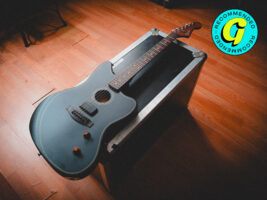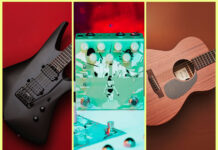
Fender Acoustasonic Standard Jazzmaster review: “this is a wonderful all-round gigging machine”
$629/£569, fender.com
Amid the furore surrounding Fender’s Indonesian-made Standard Series launch back in January, the inclusion of a pair of $600 Acoustasonics in the range somewhat got lost, but as our review of the Acoustasonic Standard Telecaster demonstrated, this most accessible route to hybrid acoustic-electric oddness is perhaps its most compelling yet.
READ MORE: Fender Acoustasonic Standard Telecaster review: “these are sounds you don’t hear in a live context very often”
Of course, many of us will remember Fender’s earlier attempts at electric-shaped inexpensive acoustic guitars – the spectre of the Telecoustic and Stratocoustic weighs heavily on the silhouette of the new Acoustasonic versions in some eyes. The Jazzmaster, however, carries no such baggage, and perhaps that’s why people don’t seem so reflexively put off by it in Acoustasonic form. So can this new more affordable version bring more players into the fold?
Fender Acoustasonic Standard Jazzmaster. Image: Jason Mays
Fender Acoustasonic Standard Jazzmaster – what is it?
Like the rest of the Standard series – including the Acoustasonic Telecaster – this Jazzmaster is crafted in Indonesia by Cor-Tek. Cor-Tek is the brand behind Cort of course, but also produces instruments for various big brands in Asia, most notably PRS’s sensational SE line.
As with the Mexico-made Player version, the Standard does away with the onboard rechargeable battery of the US-made original for a classic nine-volter. It’s worse for the environment perhaps, but certainly more reassuring in a live scenario – if your battery dies you can just swap it and the gig doesn’t have to end.
Like the Telecaster model, the Standard series swaps the mahogany body wood for common substitute nyatoh, while the top is spruce. Here it’s finished in a fetching matt black, but it’s also available in Natural or Honey Burst.
A more notable omission from the Standard is the Fender/Fishman-designed Acoustic Engine – there’s no modelling mixing mic’d acoustic ‘images’ with the piezo pickup signal here, in its place is a single tone knob that blends the sound of the Shawbucker magnetic pickup with the under-saddle Fishman transducer.
Without a doubt this is a more straightforward experience than the more expensive options with their myriad options for blending electric and acoustic sounds – but does it cut things too far? Let’s find out.
Image: Jason Mays
Fender Acoustasonic Standard Jazzmaster – playability and sounds
I’ll admit, ever since the first Acoustasonic Telecaster was first introduced in 2019, I’ve always felt kind of “meh” about the concept – especially in its American guise. Sure, it’s an interesting concept that blurs the line between acoustic and electric in ways that undeniably appeal – but who’s spending $2,000 on a curiosity?
The Player version certainly helped that but was still over a grand, so the Standard version feels a lot more where I’d want this guitar to be – it’s still not Squier cheap of course, but it’s at a level now where I can see people taking a swing and seeing what the fuss is about.
Removing the guitar from its box (there’s no case supplied) and the organic, tactile, unvarnished wood nature of the thing that was so enjoyable about the more expensive Acoustasonics is present and correct.
In hand, the neck is a comfortable if generic Deep C with a 12” radius. That’s a real rosewood board on there too, and the finishing on the top of it is very good with no sharp fret edges and a smooth feel.
When you’re as familiar with the Jazzmaster as I am, you get used to knowing what it feels like when you strap one on – it led me to being pleasantly surprised about how light it is. The stripped-down electronics package may contribute to make this lighter than other Acoustasonics I’ve played and substantially less than a solidbody JM – I almost forgot I even had the guitar on at times.
Given that most people who buy this guitar are probably seeing it as a live tool that can be used to provide both electric and acoustic sounds into one rig, I tailored my review setup appropriately. This means pairing my trusty Strymon Iridium and with my Bose S1 Pro+ with the Iridium serving as a foot in the electric guitar world and the Bose (with some of the acoustic settings engaged in the S1 Pro’s ToneMatch feature) providing a more straightforward acoustic sound.
Image: Jason Mays
With the above in mind, it’s important at this point to consider the kind of rig you have to use with an Acoustasonic because of its piezo and magnetic pickups. The ability to switch between an amp modelling pedal and PA means you can get the best from the Shawbucker and piezo, respectively. You’ll achieve a warmer, fuller acoustic sound through an FRFR speaker while the humbucker will have more presence and cut through a guitar amp – or a modelled one.
The lines begin to blur more as you explore things with the tone control to mix the two pickups, but consider your needs. Units like the Neural DSP Quad Cortex, Fender Tone Master and Line 6 HX Stomp can prove to be great partners to the Acoustastonic for the live stage in this regard – allowing players to switch from an acoustic preamp to a tube amp model with the click of a footswitch.
When I set the tone knob right in the middle to get a balanced sound that didn’t veer too far into either extreme, I was pleasantly surprised by the way it does a very impressive job of reflecting both at the same time without feeling like you’re being short-changed. It’s a unique sound – bold and warm – that’s perfect for jazz enthusiasts looking to channel their inner Jack White.
The presence of just a dreaded under-saddle pickup on the acoustic side is always a bit of a red flag for any budget acoustic, but bypassing the Iridium’s guitar amp models and flipping the blend knob all the way to the Fishman pickup was another enjoyable surprise.
Lush and expansive, the Fishman pickup never sounds too shrill or sterile – whether you’re gently fingerpicking or smashing out some straight-ahead strumming, this is a perfectly credible and usable acoustic tone, especially in a live environment.
The electric side of things should, theoretically, be more straightforward – Tim Shaw knows how to design a pickup and the guitar’s physical dimensions are less impactful when playing through a magnetic pickup.
Sticking a Chase Bliss Brothers AM in front of the Iridium, it’s immediately apparent that this guitar has some very pleasing bite. Though it’s not an ‘electric’ pickup sound that you may be familiar with from traditional Fenders, the Shawbucker has a sense of classic humbucker depth and girth that’s a very appealing voice to switch to. Lead lines sound clear and easily cut through the mix, while chords ring out with just the right amount of grit and low-end presence without losing clarity.
While some of us might be happy to roll out the Acoustasonic for the odd song, the quality of both acoustic and electric sounds on tap here make it a credible option to be your main guitar for the whole set.
Image: Jason Mays
Fender Acoustasonic Standard Jazzmaster – should I buy one?
While the previous Acoustasonic instruments have found their own audiences and user bases, there’s no doubt that the price of entry was a real sticking point for many – and you could argue that they might have been better off starting at this end of the price spectrum.
Because this is a correctly and carefully intentioned instrument that sets a new standard in terms of accessibility and usability in this best-of-both-worlds approach. It’s hard to think of many acoustic guitars that sound better than this plugged in at this price point, and certainly you won’t find an equivalent hybrid option doing the job either – it’s an impressive statement of intent for the Standard Series, and the best Acoustasonic to date.
At a hair over $600, it punches well above its tonal weight class and outperforms any acoustic/electric hybrid guitar this end of the market —not only showcasing one of the strongest offerings in the current Fender catalogue, but also making me even more excited about what Fender Indonesia might release next.
Fender Acoustasonic Standard Jazzmaster – alternatives
There aren’t a lot of true hybrid guitar options at this price point, and what there they tend to be things like Ibanez’s TOD10n ($749/£659) – a thinline nylon-string crossover created for Polyphia man Tim Henson.
If you want both electric and acoustic sounds in a similarly electric-style package, then the PRS SE Hollowbody Standard Piezo ($1,529/£1,299) is more electric than acoustic, but it’ll do in a pinch. Finally, if the vibe of the Acoustasonic appeals but you don’t want the electric stuff, the Fender Highway Series Dreadnought ($999/£849) is an interesting take on the live acoustic recipe.
The post Fender Acoustasonic Standard Jazzmaster review: “this is a wonderful all-round gigging machine” appeared first on Guitar.com | All Things Guitar.
Source: www.guitar-bass.net











